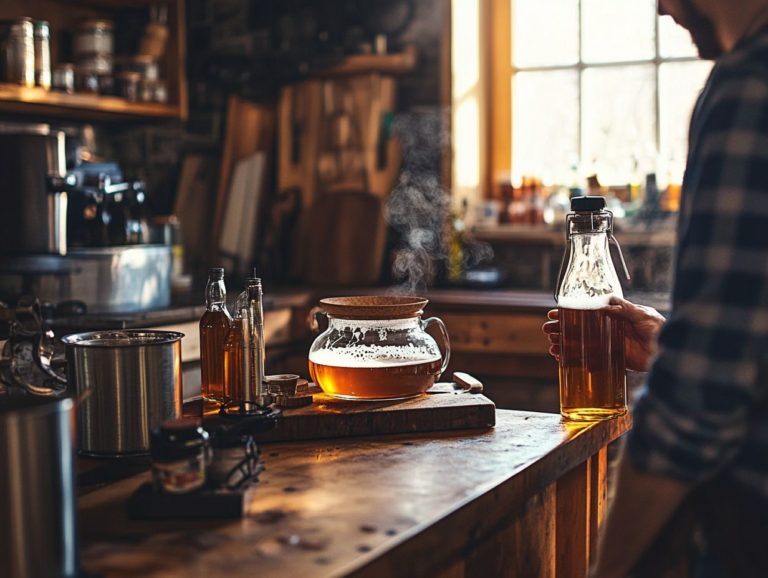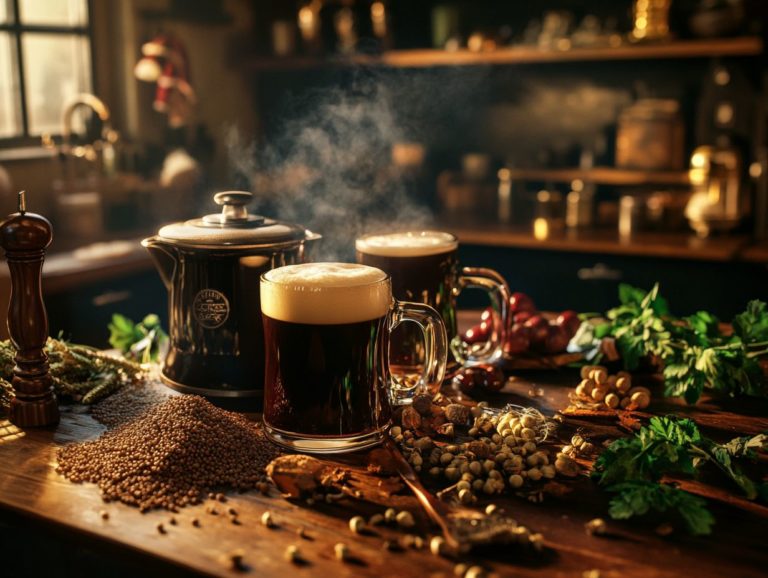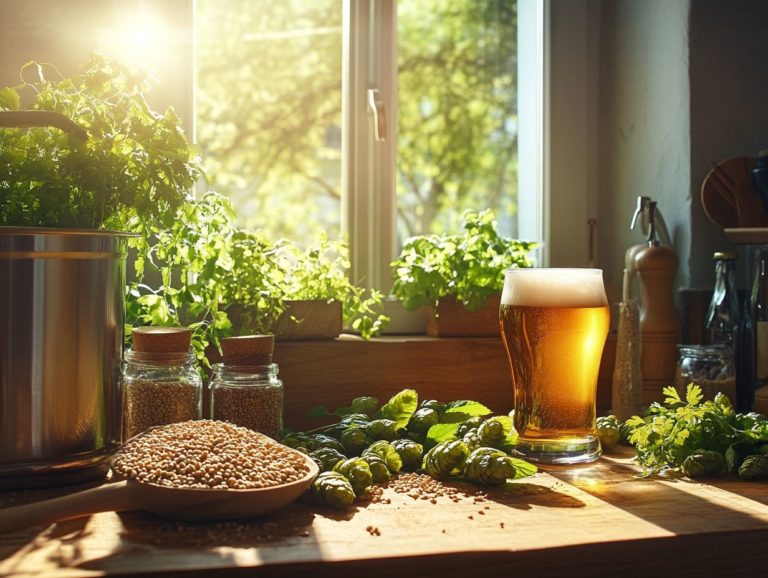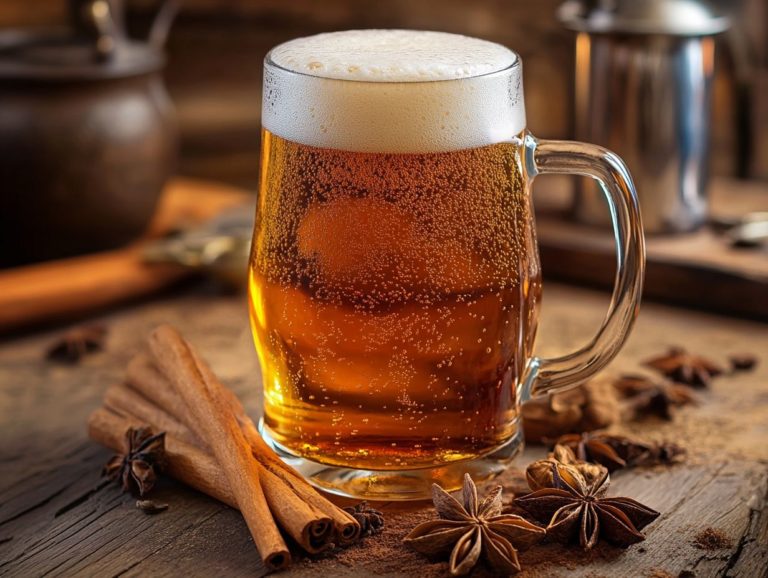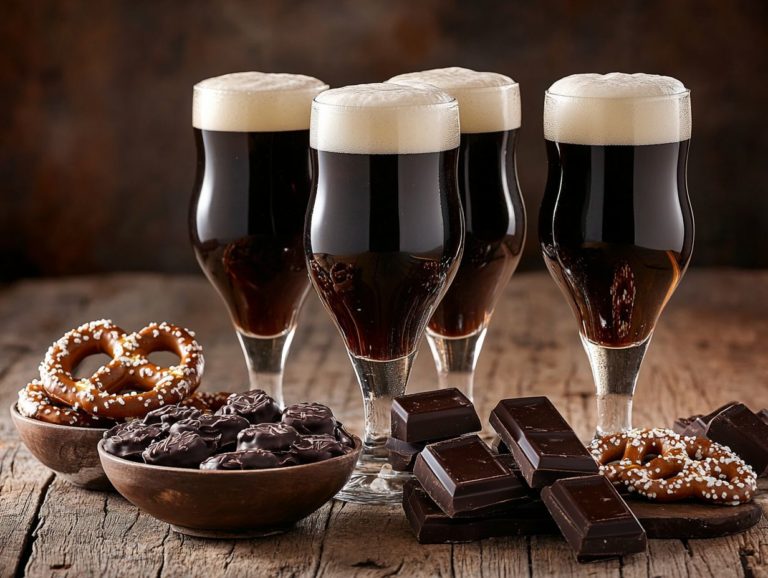10 Must-Try Beer Recipes for Home Brewing Enthusiasts
As a home brewing enthusiast eager to explore new flavors and styles, you re in for an exceptional journey! This article unveils ten must-try beer recipes designed to cater to a range of palates, from the crisp refreshment of a Classic American Pale Ale to the bold richness of a Stout and other award-winning beer styles.
In addition to these enticing recipes, you ll find essential brewing equipment, detailed step-by-step instructions, and expert tips for customizing your brews. Prepare to elevate your home brewing experience, sidestep common pitfalls, and savor the rewarding process of crafting your own distinctive beers. Enjoy the adventure!
Contents
- Get ready to brew! Here are the key takeaways that will transform your home brewing experience:
- 1. Classic American Pale Ale
- 2. Belgian Witbier
- Beer Styles: A Journey Through Flavor
- 3. English Bitter
- 4. Irish Red Ale
- 5. German Hefeweizen
- 6. India Pale Ale (IPA)
- 7. Stout
- 8. Porter
- 9. Fruit Beer
- 10. Wheat Beer
- Essential Equipment for Your Home Brewing Adventure
- Home Brewing Steps
- Customizing Beer Recipes
- Avoiding Common Mistakes
- How Can You Take Your Home Brewing to the Next Level?
- Frequently Asked Questions
- Home Brewing Beer Recipes for Beginners
Get ready to brew! Here are the key takeaways that will transform your home brewing experience:
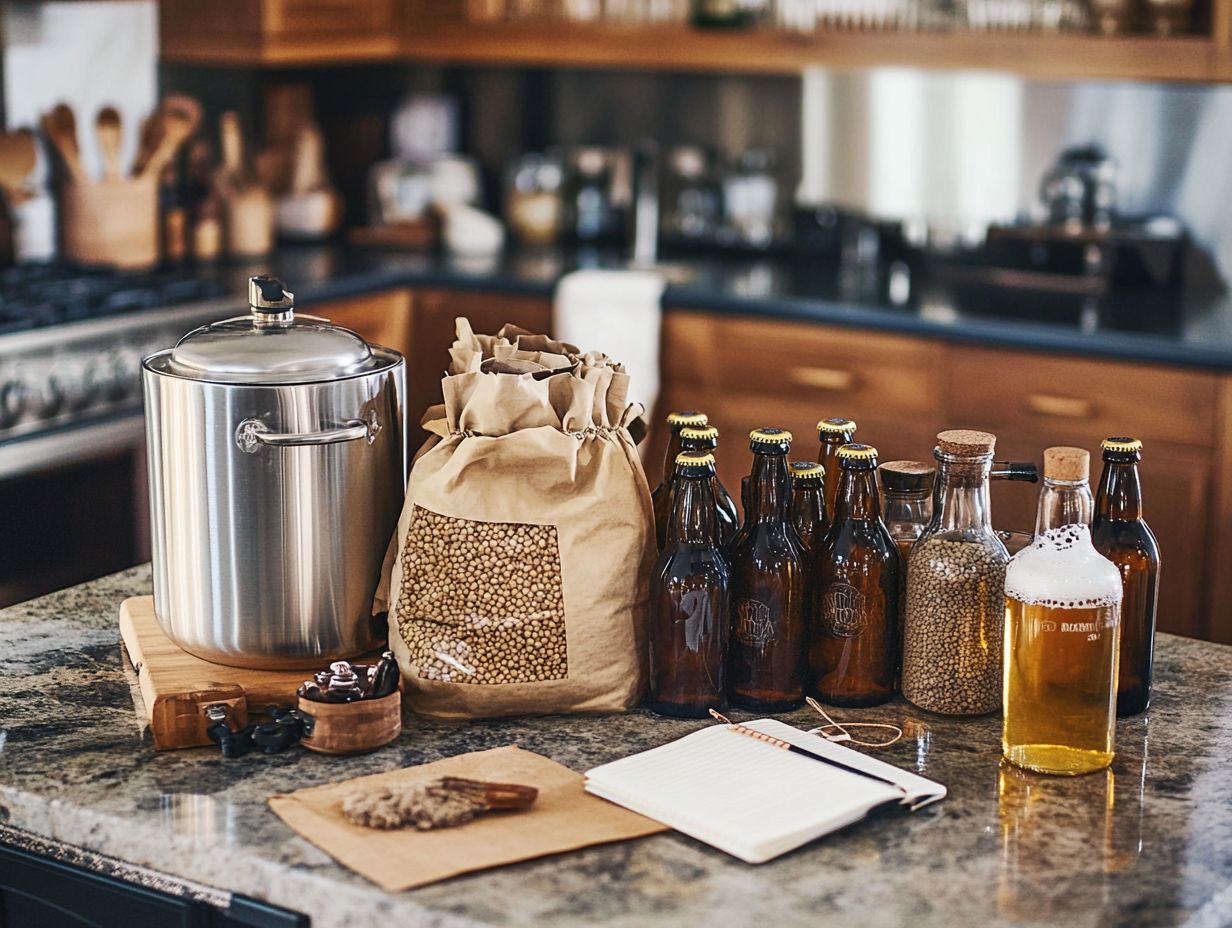
- Discover your new favorite beer by trying out these 10 must-try beer recipes for home brewing enthusiasts, including classic American Pale Ale and refreshing Belgian Witbier, inspired by successful competitions in the home brewing community.
- Take your home brewing to the next level by customizing these recipes to your own taste, whether it’s adding extra hops or experimenting with different fruits, and perfecting your brewing methods along the way.
- Avoid common mistakes and enjoy the benefits of home brewing, such as saving money and creating unique, high-quality beer that you can proudly share with friends and family, much like New York City homebrewers do.
1. Classic American Pale Ale
The Classic American Pale Ale stands as a classic beer style that perfectly balances malt and hop flavors, solidifying its strong presence in the craft beer scene. This is particularly true among New York City homebrewers, who have honed their brewing techniques to achieve remarkable results in competitions.
This beloved style typically features a percentage of alcohol in the beer ranging from 4.5% to 6.2%, offering a sessionable experience while still delivering a robust flavor profile. With a gravity measurement usually hovering around 1.045 to 1.060, it strikes a fine balance that appeals to a wide array of enthusiasts and judges in home brewing competitions.
The brewing techniques often employed include dry hopping, which amplifies aroma, alongside the use of both American and English hop varieties, celebrated for their bold citrus and pine notes. Notable hops like Northern Brewer hops also play a significant role in crafting killer concoctions.
Notable brewers like Phil Clarke Jr. have played a significant role in elevating this style, winning accolades at various events and inspiring homebrewers throughout the region. As a result, the Classic American Pale Ale has become a standard bearer in local competitions and the broader brewing community.
2. Belgian Witbier
Belgian Witbier is a truly refreshing and aromatic beer style that stands out thanks to its unique fermentation process. It often incorporates spices like coriander and orange peel, making it a beloved choice for home brewers looking to craft exceptional concoctions inspired by traditional Belgian methods.
This delightful brew typically boasts a wheat base, which lends it a hazy appearance and a light body that s simply inviting. The fermentation process is enriched by specific yeast strains, which introduce subtle fruity esters and spicy phenols, enhancing the overall flavor profile. Hops are generally used sparingly, allowing the spices and the character of the yeast to take center stage.
If you’re venturing into the world of home brewing, using Wyeast 1728 can unlock a wealth of rich fermentation nuances. You can also experiment with various ingredients, like lemongrass or ginger, to put your own spin on this classic style, ensuring that each batch is distinctly yours. Studying judges’ notes from successful competitions can offer valuable insights for your brewing process.
Home brewing is not just about making beer; it s about the joy of creating something unique. Enjoy the process!
Don t wait! Start brewing your first batch today and impress your friends with your unique creations!
Beer Styles: A Journey Through Flavor
As a home brewer, exploring various beer styles can enhance your brewing skills and palate. Here, we delve into three captivating styles: English Bitter, Irish Red Ale, and German Hefeweizen.
3. English Bitter
English Bitter is a classic beer style that you ll come to appreciate for its moderate alcohol content and well-balanced malt flavors. This style appeals to both novice drinkers and seasoned beer aficionados alike, especially those who savor the subtle complexities often highlighted in homebrewing competition results.
Typically, you ll find that English Bitter showcases a malt extract profile rich in caramel and toasted notes, delivering a rounded mouthfeel without overwhelming sweetness. Achieving that ideal balance demands careful ingredient selection, such as a mix of traditional English malts like Maris Otter and darker crystal malts. This attention to detail is crucial for a well-crafted brew.
As a home brewer, it s vital to manage hop additions thoughtfully. Ensuring that the bitterness complements rather than overpowers the malt profile is key. Don’t hesitate to experiment with different yeast strains each choice can transform your brew into something extraordinary!
Regular taste testing throughout the brewing process will allow you to make timely adjustments. Ultimately, this can lead to a refined recipe that truly shines in any competitive setting.
4. Irish Red Ale
Irish Red Ale is a captivating beer style, known for its rich crimson hue and toasty malt profile. This style makes it a favorite among home brewers eager to craft delicious concoctions that strike the perfect balance of flavors.
With an alcohol by volume (ABV) typically ranging from 4.2% to 5.5%, this delightful beverage offers a refreshing yet satisfying experience. Expect dominant notes of caramel and toffee in the malt profile, artfully balanced by a hint of hop bitterness, resulting in a well-rounded and approachable taste.
Brewers often use techniques like decoction mashing or the incorporation of roasted barley to elevate these distinctive characteristics. These methods not only enhance complexity and depth but also allow for the development of rich aromas and a fuller body.
Each sip of Irish Red Ale becomes a more enjoyable experience, inviting you to savor the craftsmanship behind this beloved style. This approach is particularly effective in creating balanced beer styles, as appreciated by home brewers and judges alike.
5. German Hefeweizen
German Hefeweizen is a timeless wheat beer style that captures attention with its cloudy allure and enchanting banana and clove flavors. These delightful notes arise from a unique fermentation process that promotes the development of aromatic compounds, making it a beloved choice among home brewers who embrace specific brewing methods and yeast strains like WLP001 California Ale.
To craft that signature taste profile, focus intently on your yeast selection. Strains like Wyeast 3068 or White Labs WLP300 are celebrated for producing those characteristic esters and phenols that define this style. Keeping your fermentation temperature warm, ideally between 68 F to 75 F, will enhance those fruity notes.
A gentle stirring of the yeast slurry can also infuse more aromatic compounds into your brew. When crafting your Hefeweizen, aim for a high percentage of malted wheat paired with noble hops. This combination strikes the perfect balance between sweetness and bitterness, yielding a refreshing beer that embodies the true essence of the style.
This approach not only highlights the unique characteristics of German Hefeweizen but also invites you to unleash your creativity and experiment as you master this cherished brewing tradition. Consider exploring other yeast strains like Wyeast 5335 to add a twist to your brew.
6. India Pale Ale (IPA)
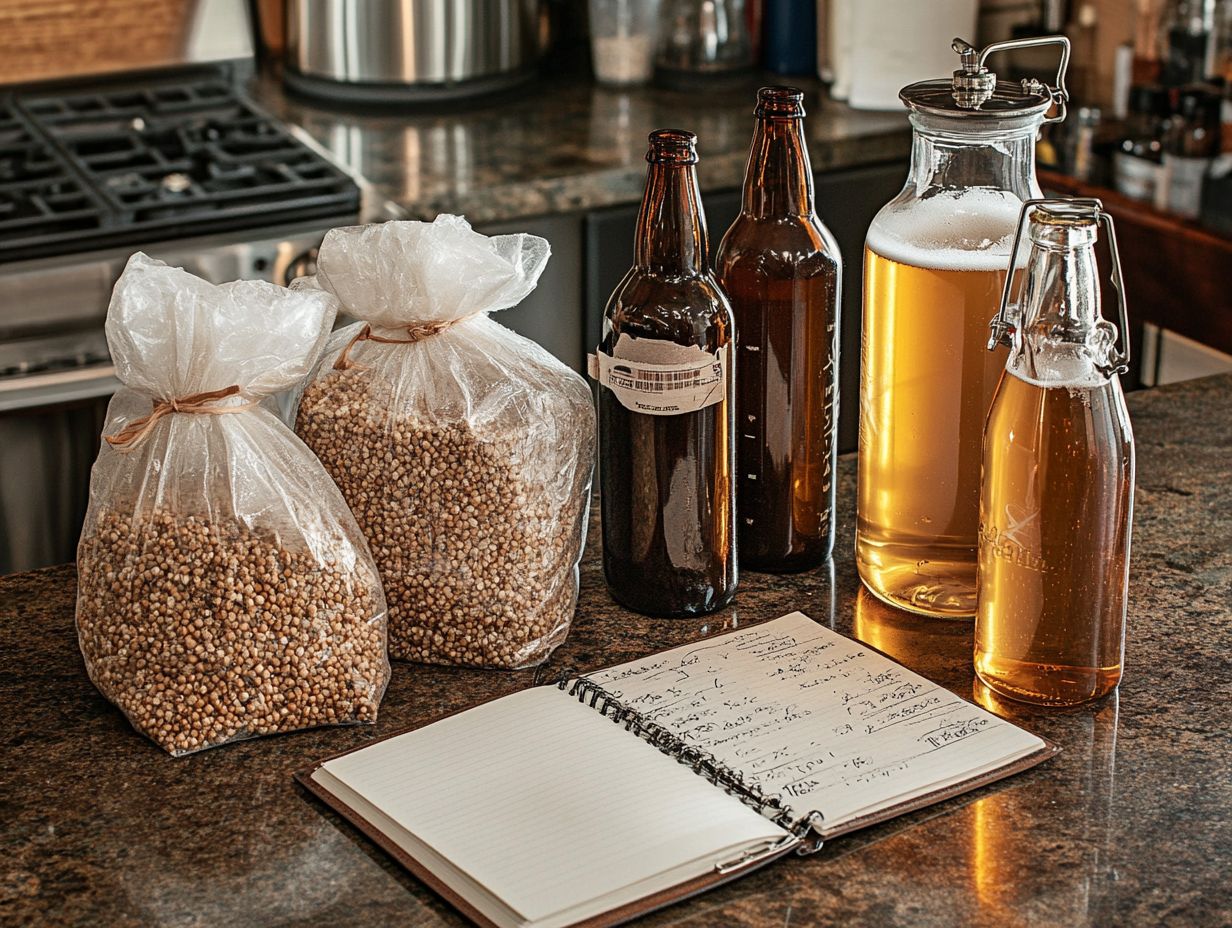
India Pale Ale (IPA) has become a beloved staple among craft beer aficionados, known for its bold hop flavors and aromas. This distinctive profile is crafted using Northern Brewer hops and a variety of malt extracts, enabling you to create exceptional brews that shine in competitions like the Knickerbocker Battle of the Brews.
This cherished style is far from one-dimensional; it encompasses a range of types, including American, English, and New England IPAs, each offering a unique tasting adventure. The diverse selection of hops plays a crucial role in shaping the beer’s flavor profile citrusy, floral, or even piney notes can emerge, depending on your choices.
This variety allows home brewers to explore different styles and hone their skills in creating distinct IPAs. If you’re keen to brew your own, grasping recipe extraction methods is vital. As a home brewer, you can experiment with different boil times and dry hopping techniques to draw out the desired flavors from the hops. Don’t forget to check out the best craft beer recipes for home brewing for inspiration.
This experimentation leads to a customized brew that not only aligns with your personal taste but also pays homage to the rich heritage of IPAs. Notable brewers like Ray Girard and Mathias Willner have mastered these techniques, showcasing their expertise in successful IPA concoctions.
7. Stout
Stout is a rich and complex beer style, often distinguished by its dark color and deep flavors derived from various types of malt extract. It s a rewarding choice for home brewers like you who pay careful attention to gravity measurement and alcohol by volume to perfect your brews. Brewers like Zack Kinney and Jonathan Moxey have demonstrated how careful attention to these factors can lead to exceptional stout creations.
The brewing process usually involves using roasted malts, which impart those signature chocolatey, coffee-like notes that stouts are known for. Depending on whether you’re crafting a dry stout, oatmeal stout, or imperial stout, the combination and proportion of malts can vary significantly.
Brewers like Jason Rodriguez and Lee Jacobson have excelled in crafting these different styles, each bringing their unique touch to the beloved stout. To achieve your desired flavor profile, monitoring specific gravity throughout fermentation is crucial.
By taking regular gravity readings, you can adjust the quantity of fermentable sugars or determine the optimal time to add adjuncts additional ingredients that enhance flavor ensuring that the final product aligns with your vision of richness and balance. This careful approach is what sets apart award-winning stouts in competitions.
Careful attention to detail enhances your brewing experience and leads to exceptional stout creations that you can proudly share.
8. Porter
Porter is a classic beer style that captivates with its deep, roasted flavors, perfect for those who truly appreciate the intricate brewing methods involved. When you use high-quality malt extract, you can create fantastic brews that evoke rich chocolate and coffee notes, making every sip a delightful experience.
Originating in London during the 18th century, this beloved beer was originally crafted for the working-class porters, who desired a beverage that delivered both satisfying taste and substantial body. The flavor profile of Porter boasts complex layers of caramel, toffee, and dark fruits, all harmonizing beautifully with roasted undertones.
For a modern twist, some home brewers in New York have started using Northern Brewer hops to add a distinctive bitterness. If you’re a home brewer eager to elevate your Porter experience, consider techniques like cold steeping crushed dark malts or experimenting with various yeast strains like WLP001 California Ale to enhance the final product. You might also want to check out these 10 must-try tips for home brewing to further refine your craft.
By utilizing a combination of roasted barley and chocolate malt, you can further enrich those delightful flavors, resulting in a truly remarkable brew that appeals to a diverse array of palates.
9. Fruit Beer
Fruit beer represents an innovative brewing style that marries traditional techniques with the vibrant essence of various fruits. This invites you to explore and experiment with your home brew recipe extraction methods to create captivating concoctions that truly delight the palate.
You can utilize a variety of fruits in your brewing endeavors, each imparting its own unique aromas, flavors, and even colors to the final product. For example, citrus fruits like oranges and lemons can brighten your brew with their zesty acidity, while berries introduce a delightful sweetness and depth. Stone fruits, such as peaches and cherries, add a juicy and refreshing flavor.
As you consider the fermentation process, it’s crucial to grasp how the natural sugars in fruits influence yeast activity. Strive to balance the fruit’s sweetness with the beer s bitterness to craft a harmonious flavor profile. You can add fruit after the primary fermentation to keep its fresh taste or utilize fruit purees to regulate flavor intensity. By experimenting with diverse combinations and timing, you’re bound to uncover exciting new dimensions in flavor and aroma.
10. Wheat Beer
Wheat Beer is a refreshing style that invites you into a world of light, effervescent character, often achieved through careful brewing and fermentation. This makes it a favored choice among home brewers who appreciate its versatility, sometimes even crafting variations that mirror the qualities of an American pale ale or a Berliner Weisse.
As a brewer, you have the opportunity to explore several types of Wheat Beer, including Hefeweizen, Witbier, and American Wheat, each demanding its own unique ingredients and fermentation conditions. For instance, the distinct banana and clove notes of Hefeweizen emerge from specific yeast strains and higher fermentation temperatures. Meanwhile, Witbier often incorporates spices like coriander and orange peel, enriching its flavor complexity.
Your success hinges on proper temperature control and fermentation timing, which are crucial for achieving the desired aroma and mouthfeel. Choosing the right yeast, like Wyeast 5335, is crucial for great Wheat Beer and brewing methods becomes essential in crafting a Wheat Beer that is not only refreshing but also bursting with flavor.
Essential Equipment for Your Home Brewing Adventure
Start your thrilling home brewing journey today! You’ll want to gather a variety of essential equipment that will facilitate your brewing methods and fermentation process. This setup empowers you to craft a variety of amazing beer styles, whether you’re crafting a Classic American Pale Ale, a Scottish wee-heavy, or an elegant Belgian Witbier.
A fermentation vessel, often crafted from glass or food-grade plastic, is absolutely critical. It provides the ideal environment for yeast to convert sugars into alcohol while allowing CO2 to escape. A brewing kettle typically a large pot built to withstand high heat is essential for boiling your ingredients and infusing the wort with rich flavors from hops or other additives.
Investing in thermometers and temperature regulators is a wise choice, as they ensure that fermentation occurs under optimal conditions, significantly enhancing the flavor profile of your final product. Together, these tools not only streamline the brewing process but also empower you to experiment and achieve the unique beer characteristics you desire.
Gather your equipment and get brewing. The perfect beer awaits you!
Home Brewing Steps
What Are the Basic Steps of Home Brewing?
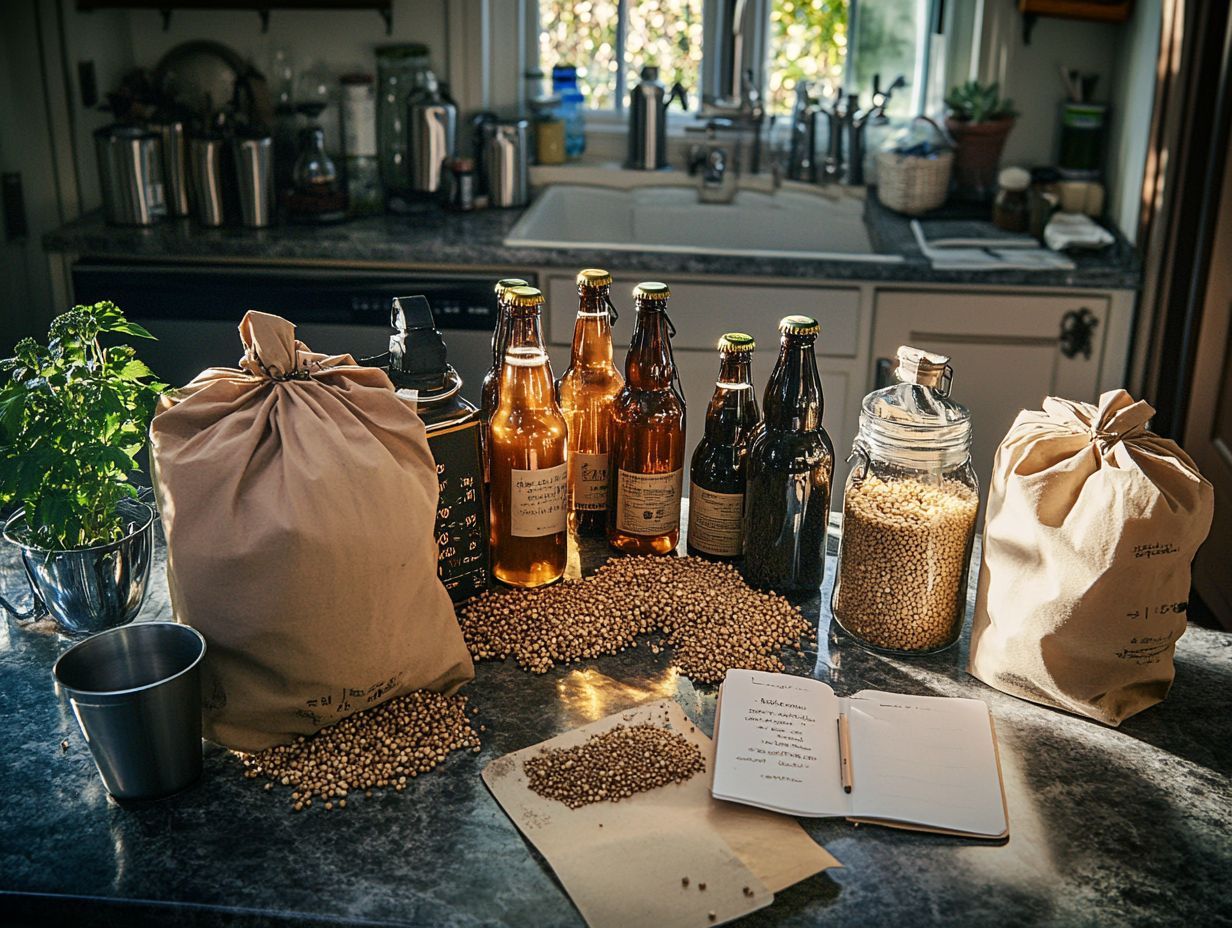
Home brewing is an art that involves several fundamental steps, guiding you through a successful fermentation process. This allows you to extract the finest flavors from your meticulously chosen ingredients and craft your ideal beer recipe, whether you’re leaning towards an IPA, a rye malt beer, or a stout.
To embark on this exciting journey, start by gathering all the necessary ingredients: malt, hops, yeast, and water. It s essential to measure and prepare each one accurately, as this precision significantly influences the overall taste.
Next, dive into the mashing process, where you steep the grains in hot water to convert starches into sugars. After that, boil the mixture, known as wort, and add hops like Northern Brewer to develop the desired aroma and bitterness.
Once you ve cooled the mixture, transferring it into a fermentation vessel is crucial. This is where the magic truly begins by adding yeast.
During fermentation, patience becomes your greatest ally, as the yeast works its wonders, transforming sugars into alcohol and increasing the alcohol by volume (ABV).
Bottling requires your utmost attention to avoid contamination, ensuring that the final product is both delicious and safe to enjoy. Each step in this brewing process plays a pivotal role, ultimately leading to that first delightful sip that makes it all worthwhile.
Customizing Beer Recipes
How Can You Customize These Recipes to Your Taste?
Customizing beer recipes to align with your taste is one of the most exhilarating aspects of home brewing. It gives you the freedom to experiment with a variety of ingredients and techniques, allowing you to craft unique and remarkable brews that truly reflect your personal preferences and style.
One of the key factors in this creative journey is selecting different hop varieties, each bringing its own flavor profile to the table, from vibrant citrus notes to rich earthy undertones.
The choice of malt types plays a significant role, influencing not just the beer’s color and body but also its sweetness or bitterness based on the specific malts you choose.
For example, caramel malts can elevate a brown ale s sweetness and complexity, while roasted malts are essential for imparting those characteristic dark chocolate notes in a stout.
Adjusting fermentation temperatures can profoundly impact the yeast s behavior, ultimately altering the beer’s aroma and taste. Cooler temperatures might yield a cleaner finish that s perfect for lagers, whereas warmer fermentations can produce delightful fruity esters that are ideal for certain ales.
The possibilities are endless! Dive in and unleash your creativity in brewing.
Avoiding Common Mistakes
What Are Some Common Mistakes to Avoid When Home Brewing?
When you’re home brewing, it s essential to recognize common mistakes that could jeopardize your efforts. Issues like improper sanitation, inaccurate gravity measurements, and neglecting the fermentation process can significantly affect the final flavor and quality of your beer.
These pitfalls don’t just compromise taste; they can also lead to undesirable changes in aroma and clarity, ultimately diminishing the enjoyment of your final product.
To ensure a successful brewing experience, prioritize meticulous sanitation practices. Even the smallest contaminants can ruin an entire batch.
Taking precise gravity readings with a hydrometer is crucial for tracking fermentation progress and achieving your desired alcohol content. By emphasizing these key elements, you can truly elevate your brew, creating a product that not only tastes exceptional but also showcases your brewing prowess.
Don’t forget to pay attention to the judges’ notes from successful competitions to refine your techniques.
Start brewing today and let your taste buds guide your adventure!
What Are the Benefits of Home Brewing?
Home brewing offers exciting benefits that every beer lover should explore! It allows you to craft customized beer styles that align perfectly with your personal preferences. This hobby fosters your creativity and provides a rewarding experience that deepens your appreciation for the intricate brewing process.
As you embark on this brewing adventure, you will likely discover significant cost savings compared to purchasing craft beers from your local store. The thrill of experimentation becomes a delightful aspect of your journey, enabling you to modify ingredients and explore various brewing techniques to achieve unique flavors and aromas. For inspiration, check out these 10 classic lager recipes for home brewing that can lead to outstanding brews.
Home brewing opens an exciting door to explore a multitude of beer styles, from hoppy IPAs to rich stouts, while enhancing your understanding of the ingredients that shape each profile. For beginners looking for guidance, trying out 10 easy beer recipes can be a great start. This hobby not only cultivates a sense of accomplishment but also elevates your social experiences. Sharing your homemade brews with friends and family will create lasting memories and foster a vibrant community around this cherished craft.
How Can You Take Your Home Brewing to the Next Level?
Consider entering your creations in competitions like the Knickerbocker Battle of the Brews, judged by experts such as Phil Clarke Jr., Ray Girard, Lee Jacobson, Jacques Alcabes, Mathias Willner, Zack Kinney, Jonathan Moxey, Jason Rodriguez, and Keith Koval.
To elevate your home brewing experience, look into advanced techniques like precise temperature control and explore unique yeast strains such as Wyeast 1728. Additionally, try out 5 quick beer recipes for busy home brewers to perfect your recipe extraction methods, giving you the power to craft exceptional beers that truly stand out in any competition.
Innovative tools like programmable brew systems and advanced fermentation chambers help you maintain perfect conditions for yeast activity. This enhances the flavor and aroma of your brews. Don’t forget the importance of tools like gravity measurement devices and alcohol by volume calculators in perfecting your brew.
Integrating techniques like dry hopping—adding hops to beer after the boil to enhance aroma—or experimenting with barrel aging can add unique characteristics that elevate a range of beer styles, from IPAs to stouts. Utilizing Northern Brewer hops for dry hopping can particularly enhance the aroma complexities. By mastering these methods and applying them thoughtfully, you can significantly increase your chances of gaining recognition and success in home brewing competitions, where quality and creativity reign supreme. For more tips, take inspiration from 5 easy beer recipes for home brewing success and notable brewers like Keith Koval and Zack Kinney.
Frequently Asked Questions
Here are some common questions that home brewing enthusiasts often ask.
What are some popular types of beer recipes for home brewing enthusiasts?
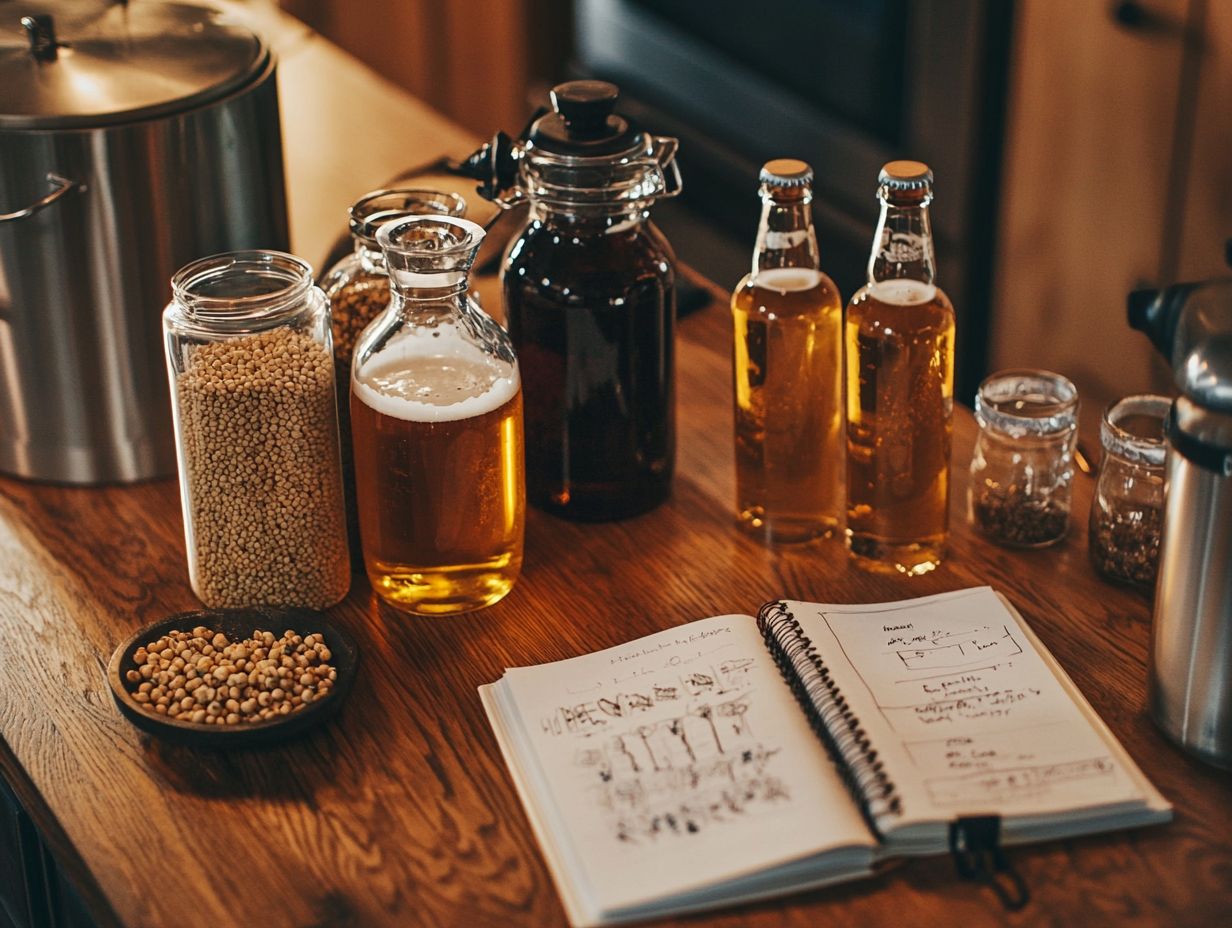
Some popular types of beer recipes for home brewing enthusiasts include American pale ale, IPA, stout, wheat beer, Berliner Weisse, Hefeweizen, and Belgian ale.
Where can I find these 10 must-try beer recipes for home brewing enthusiasts?
These recipes can be found online on brewing forums, home brewing websites, and in brewing recipe books. Consider exploring resources from renowned brewers like Phil Clarke Jr. and Jonathan Moxey.
Do I need special equipment to try these beer recipes at home?
Yes, you will need basic home brewing equipment such as a brewing kettle, fermenter, hydrometer, and bottles. You may also need specific equipment for certain recipes, like a grain mill for all-grain recipes, and specific yeast strains like WLP001 California Ale for certain beer styles.
Can I modify these beer recipes to suit my taste preferences?
Absolutely! Home brewing is all about experimentation and creating unique flavors. Feel free to adjust the ingredients and techniques in these recipes to make them your own, whether by using different yeast strains like Wyeast 5335 or incorporating unique ingredients like rye malt.
Home Brewing Beer Recipes for Beginners
Are these beer recipes suitable for beginners in home brewing?
Yes, these recipes are great for beginners. They use simple techniques and ingredients.
Make sure to research and understand the steps involved in brewing before you start. Consider beginning with easier recipes like a Scottish wee-heavy or a malt extract brew.
Can I use different types of yeast for these beer recipes?
Yes, you can experiment with different yeast types to create unique flavors. Use the appropriate yeast for your beer style.
Different yeast types can influence the taste and aroma of your beer. For a Belgian specialty ale, consider using strains from Wyeast.
Explore different yeast strains and discover the amazing flavors you can create!

